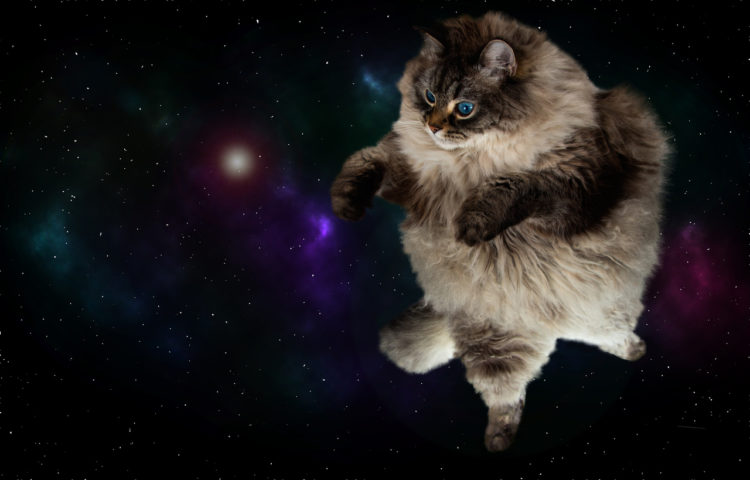Jones, Alien
 Image Source
Image Source
Sigourney Weaver’s Ellen Ripley was many things — warrant officer on an interstellar freighter, seminal science fiction heroine, and most importantly, a survivor. But Ripley wasn’t the only member of the Nostromo crew to outlast the terrifying menace of the “xenomorph,” the titular Alien from Ridley Scott’s 1979 SF/horror masterpiece.
Jonesey, an orange tabby — and ship’s cat on the Nostromo — also made it to the very end, eventually sharing a cryostasis cabinet with Ripley to sleep out the long journey back to the solar system.
Like other ship’s cats in human history, Jones was probably aboard the Nostromo as a mouser as well as a fuzzy companion for homesick members of the crew. And like all domestic cats, Jonesey retained his wild instincts, which helped him survive the stalking, slithering, saliva-soaked creature from artist H.R. Giger’s worst nightmares. Maybe it was his excellent night vision, maybe it was his heightened sense of smell, or maybe his whiskers functioned as his own version of Science Officer Ash’s motion tracker, picking up “micro changes in air density.” However he managed it, Jones became well aware of the alien’s presence before his human crewmates did, and that made all the difference.
Spot, Star Trek: The Next Generation
In almost six decades of Star Trek — through movies, TV series, comic books, and novels — few ever earned the admiration of the legendarily brutal Klingons, the warlike race who were antagonists and later allies to humanity’s Starfleet. Among the entire crew of the U.S.S. Enterprise 1701-D, one individual was singled out by the Klingon Worf as “a great warrior” — a fluffy little ginger tabby named Spot.
As pet and companion to android Data, Spot became one of science fiction’s most famous cats. Spot was usually a part of Data’s endeavors to become more human. Data painted portraits of his beloved cat, learned lessons in affection from her, and even once composed a poem, which he dubbed “Ode to Spot.” suggesting the android found it much easier to read his feline friend.
Like Alien’s Jonesey, Spot was a survivor, outlasting a degenerative virus that almost wiped out the Enterprise crew and later surviving the destruction of the ship itself.
The Partners, “The Game of Rat and Dragon”
In this beloved 1955 story from the writer Cordwainer Smith, humans have conquered the challenge of interstellar travel and are ready to begin colonizing new worlds. But there’s a serious problem: In the dark void between the stars, inscrutable aliens dubbed “dragons” prey on human ships, destroying them in attacks that last mere milliseconds.
The humans quickly figure out the “dragons” are hurt by light. But humans also realize they don’t have the reaction speed to effectively combat the dragons, even if they know an attack is imminent.
That’s where the cats — and their magnificent reflexes — come in. Specially trained kitties are paired with humans via a neural link during space voyages. The cats fly outside the human ships in their own tiny, football-shaped vessels, and when the “dragons” show up on long-range scanners, the cats use their lightning-fast reflexes to attack the enemy with concentrated light bombs, keeping their human friends safe.
It’s evident from the story that Smith is a cat lover, and much of the text centers around the relationships between the cats and their human partners, as well as what it’s like for human “pinlighters” to explore feline minds via neural links.
Speaker to Animals, “Ringworld”
So far this list has dealt with house cats — spacefaring, adventure-having cats, but domestic cats all the same.
But in Larry Niven’s Hugo Award-winning science fiction classic, “Ringworld,” cats aren’t just cuddly companions to humans — they’re also the dominant species on an unforgiving planet called Kzin, located in the system 61 Ursae Majoris, about 31 light years from our solar system.
When picturing Kzinti, think tigers. Massive, 600-pound, bipedal and intelligent tigers who see the world in simple terms — things that are delicious to eat, and things that are fun to destroy.
The most prominent Kzin in the “Ringworld” universe is an ambassador to humans, condescendingly named “Speaker to Animals.” (We humans are the animals from the Kzinti perspective, in case it wasn’t obvious.) Speaker is aggressive, violent, and under his orange fur, his body is coursing with whatever the Kzinti equivalent of testosterone is. But he’s also got a soft spot for his friends, and after a while, he demonstrates admirable loyalty. Mostly, though, he’s just badass.
M.A.D. Cat, “Inspector Gadget”
What do you do when your primary antagonist is a mysterious villain whose face is never revealed and is usually seen from behind, scheming from an executive chair with only his gauntleted right arm visible?
You add a pet cat, of course. An evil one who laughs at the villain’s nasty jokes, mirrors his emotions, and even knows how to operate a complex villain mobile, missiles and all.
If Dr. Claw is Inspector Gadget’s foil living in the shadows, then M.A.D. Cat is Claw’s public face, lending an evil grin to the villainous mastermind’s plans for world domination and a trademark yowl at the end of each episode, as Claw vows, “I’ll get you next time, Gadget!”
Claw and M.A.D. Cat are so ingrained in popular culture that R&B crooner Cee Lo Green was undoubtedly thinking of the pair when he started appearing on “The Voice” with a fluffy white Persian he named Purrfect. Every time Cee Lo spun around in his chair to claim a contestant on the popular reality competition, it was an homage to Claw and M.A.D. Cat.










I suggest you read the ahort story Spacetime for Springers, by Fritz Lieber. It’s available online. The main character is a cat named Gummitch, who believes he will become human when he learns how to drink coffee. Great story.